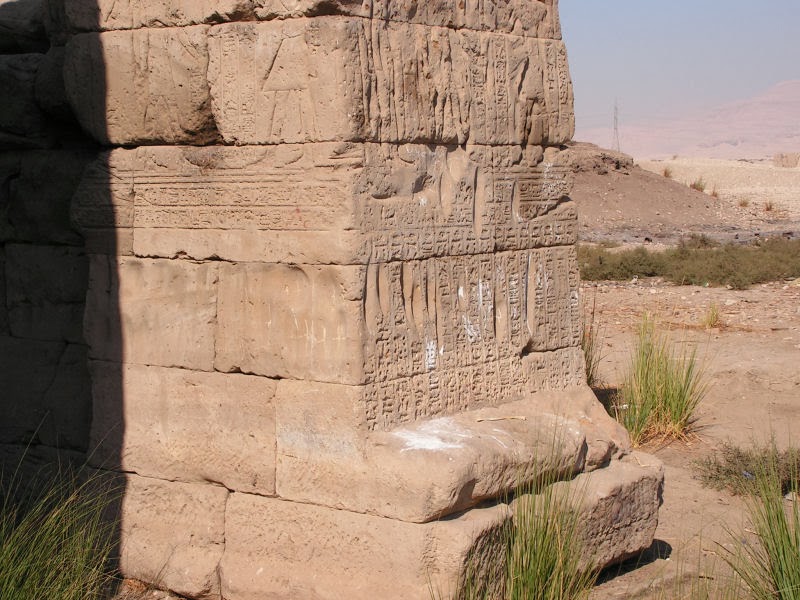Isis Temple (Ptolemaic) – Deir El Shelwit - West Bank
An ancient Egyptian temple dedicated to Isis from the Greek-Roman period 1st and 2nd centuries CE. It stands on the West bank of the Nile at Luxor, 1 km from Malqata and about 4 km south of Medinet Habu.
The Isis Temple is now open to the public and tickets are obtainable from the main ticket office at the roundabout at Qurna Mura’i, West bank.
The importance of the Isis temple of Deir el-Shelwit is because Graeco-Roman era religious buildings are rare in this area, and this is the only one not associated with the Theban Triad but with Isis.
It is a delightful small temple that in my opinion is very well worth a visit. There are at this site Toilet facilities and Parking. It is an out the way place, so I recommend that you take your own refreshments, as there are none on site.
Many emperors made additions to the temple over a 100-year period.
Today all that remains of the temple is its small main building and ruins of the propylon, along with its brick enclosure wall and the well. The temple precinct had an area of 74×51 metres; the temple itself is much smaller, 13×16 m. Its entrance faces east. The outer walls don't have much decoration but on the inside the reliefs are well preserved and some have colour. The shrine is surrounded by a corridor from which side chapels and a wabet (place of cleansing) open; also the stairs lead to the roof from this corridor. On the southern side of the outer wall some stone blocks from earlier buildings had been reused, judging from the reliefs on them most of them appear to be from Medinet Habu.
The propylon is 60 meters east from the temple; it was the original entrance to the site. It is lavishly decorated on all sides with scenes of offerings being made to the gods. Roman emperors Galba, Otho and Vespasian are depicted. They reigned during 69 CE.
According to inscriptions on the propylon, construction of the Isis temple started around the beginning of 1st century CE. No earlier building is known to have stood on this site. According to one theory the temple's construction started under the reign of Nectanebo II and reached its finished form during the Greek-Roman era.
An ancient Egyptian temple dedicated to Isis from the Greek-Roman period 1st and 2nd centuries CE. It stands on the West bank of the Nile at Luxor, 1 km from Malqata and about 4 km south of Medinet Habu.
The Isis Temple is now open to the public and tickets are obtainable from the main ticket office at the roundabout at Qurna Mura’i, West bank.
The importance of the Isis temple of Deir el-Shelwit is because Graeco-Roman era religious buildings are rare in this area, and this is the only one not associated with the Theban Triad but with Isis.
It is a delightful small temple that in my opinion is very well worth a visit. There are at this site Toilet facilities and Parking. It is an out the way place, so I recommend that you take your own refreshments, as there are none on site.
Many emperors made additions to the temple over a 100-year period.
Today all that remains of the temple is its small main building and ruins of the propylon, along with its brick enclosure wall and the well. The temple precinct had an area of 74×51 metres; the temple itself is much smaller, 13×16 m. Its entrance faces east. The outer walls don't have much decoration but on the inside the reliefs are well preserved and some have colour. The shrine is surrounded by a corridor from which side chapels and a wabet (place of cleansing) open; also the stairs lead to the roof from this corridor. On the southern side of the outer wall some stone blocks from earlier buildings had been reused, judging from the reliefs on them most of them appear to be from Medinet Habu.
The propylon is 60 meters east from the temple; it was the original entrance to the site. It is lavishly decorated on all sides with scenes of offerings being made to the gods. Roman emperors Galba, Otho and Vespasian are depicted. They reigned during 69 CE.
According to inscriptions on the propylon, construction of the Isis temple started around the beginning of 1st century CE. No earlier building is known to have stood on this site. According to one theory the temple's construction started under the reign of Nectanebo II and reached its finished form during the Greek-Roman era.



























Comments
Post a Comment